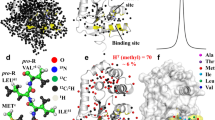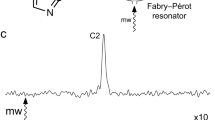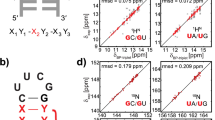Abstract
XH/π interactions make important contributions to biomolecular structure and function. These weakly polar interactions, involving π-system acceptor groups, are usually identified from the three-dimensional structures of proteins. Here, nuclear magnetic resonance spectroscopy has been used to directly detect methyl/π (Me/π) interactions in proteins at atomic resolution. Density functional theory calculations predict the existence of weak scalar (J) couplings between nuclei involved in Me/π interactions. Using an optimized isotope-labelling strategy, these J couplings have been detected in proteins using nuclear magnetic resonance spectroscopy. The resulting spectra provide direct experimental evidence of Me/π interactions in proteins and allow a simple and unambiguous assignment of donor and acceptor groups. The use of nuclear magnetic resonance spectroscopy is an elegant way to identify and experimentally characterize Me/π interactions in proteins without the need for arbitrary geometric descriptions or pre-existing three-dimensional structures.
This is a preview of subscription content, access via your institution
Access options
Subscribe to this journal
Receive 12 print issues and online access
$259.00 per year
only $21.58 per issue
Buy this article
- Purchase on Springer Link
- Instant access to full article PDF
Prices may be subject to local taxes which are calculated during checkout





Similar content being viewed by others
References
Perutz, M. F. The role of aromatic rings as hydrogen-bond acceptors in molecular recognition. Phil. Trans. R. Soc. Lond. A 345, 105–112 (1993).
Desiraju, G. R. & Steiner, T. The Weak Hydrogen Bond (Oxford Univ. Press, 1999).
Meyer, E. A., Castellano, R. K. & Diederich, F. Interactions with aromatic rings in chemical and biological recognition. Angew. Chem. Int. Ed. 42, 1210–1250 (2003).
Suzuki, S. et al. Benzene forms hydrogen bonds with water. Science 257, 942–945 (1992).
Rodham, D. A. et al. Hydrogen bonding in the benzene–ammonia dimer. Nature 362, 735–737 (1993).
Tsuzuki, S., Honda, K., Uchimaru, T., Mikami, M. & Tanabe, K. Origin of the attraction and directionality of the NH/π interaction: comparison with OH/π and CH/π interactions. J. Am. Chem. Soc. 122, 11450–11458 (2000).
Tsuzuki, S., Honda, K., Uchimaru, T., Mikami, M. & Tanabe, K. The magnitude of the CH/π interaction between benzene and some model hydrocarbons. J. Am. Chem. Soc. 122, 3746–3753 (2000).
Burley, S. K. & Petsko, G. A. Amino–aromatic interactions in proteins. FEBS Lett. 203, 139–143 (1986).
Steiner, T. & Koellner, G. Hydrogen bonds with π-acceptors in proteins: frequencies and role in stabilizing local 3D structures. J. Mol. Biol. 305, 535–557 (2001).
Brandl, M., Weiss, M. S., Jabs, A., Suhnel, J. & Hilgenfeld, R. C–H···π-interactions in proteins. J. Mol. Biol. 307, 357–377 (2001).
Dingley, A. J. & Grzesiek, S. Direct observation of hydrogen bonds in nucleic acid base pairs by internucleotide 2JNN couplings J. Am. Chem. Soc. 120, 8293–8297 (1998).
Pervushin, K. et al. NMR scalar couplings across Watson–Crick base pair hydrogen bonds in DNA observed by transverse relaxation-optimized spectroscopy. Proc. Natl Acad. Sci. USA 95, 14147–14151 (1998).
Cordier, F. & Grzesiek, S. Direct observation of hydrogen bonds in proteins by interresidue 3hJNC' scalar couplings. J. Am. Chem. Soc. 121, 1601–1602 (1999).
Grzesiek, S., Cordier, F., Jaravine, V. & Barfield, M. Insights into biomolecular hydrogen bonds from hydrogen bond scalar couplings. Prog. Nucl. Magn. Reson. Spectrosc. 45, 275–300 (2004).
Cordier, F., Barfield, M. & Grzesiek, S. Direct observation of Cα–Hα···O=C hydrogen bonds in proteins by interresidue h3JCαC' scalar couplings. J. Am. Chem. Soc. 125, 15750–15751 (2003).
Vijay-Kumar, S., Bugg, C. E. & Cook, W. J. Structure of ubiquitin refined at 1.8 Å resolution. J. Mol. Biol. 194, 531–544 (1987).
Cornilescu, G., Marquardt, J. L., Ottiger, M. & Bax, A. Validation of protein structure from anisotropic carbonyl chemical shifts in a dilute liquid crystalline phase. J. Am. Chem. Soc. 120, 6836–6837 (1998).
Derrick, J. P. & Wigley, D. B. The third IgG-binding domain from streptococcal protein G. An analysis by X-ray crystallography of the structure alone and in a complex with Fab. J. Mol. Biol. 243, 906–918 (1994).
Ulmer, T. S., Ramirez, B. E., Delaglio, F. & Bax, A. Evaluation of backbone proton positions and dynamics in a small protein by liquid crystal NMR spectroscopy. J. Am. Chem. Soc. 125, 9179–9191 (2003).
Gans, P. et al. Stereospecific isotopic labeling of methyl groups for the NMR studies of high molecular weight proteins. Angew. Chem. Int. Ed. 49, 1958–1962 (2010).
Nadaud, P. S., Helmus, J. J. & Jaroniec, C.P. 13C and 15N chemical shift assignments and secondary structure of the B3 immunoglobulin-binding domain of streptococcal protein G by magic-angle spinning solid-state NMR spectroscopy. Biomol. NMR Assign. 1, 117–120 (2007).
Miclet, E., Boisbouvier, J. & Bax, A. Measurement of eight scalar and dipolar couplings for methine–methylene pairs in proteins and nucleic acids. J. Biomol. NMR 31, 201–216 (2005).
Mitchell, J. B., Nandi, C. L., McDonald, I. K., Thornton, J. M. & Price, S. L. Amino/aromatic interactions in proteins: is the evidence stacked against hydrogen bonding? J. Mol. Biol. 239, 315–331 (1994).
Weiss, M. S., Brandl, M., Suhnel, J., Pal, D. & Hilgenfeld, R. More hydrogen bonds for the (structural) biologist. Trends Biochem. Sci. 26, 521–523 (2001).
Tsuzuki, S., Honda, K., Uchimaru, T., Mikami, M. & Fujii, A. Magnitude and directionality of the interaction energy of the aliphatic CH/π interaction: significant difference from hydrogen bond. J. Phys. Chem. 110, 10163–10168 (2006).
Dougherty, D. A. Cation–π interactions in chemistry and biology: a new view of benzene, Phe, Tyr and Trp. Science 271, 163–168 (1996).
Umezawa, Y. & Nishio, M. CH/π interactions in the crystal structure of class I MHC antigens and their complexes with peptides. Bioorg. Med. Chem. 6, 2507–2515 (1998).
Umezawa, Y. & Nishio, M. CH/π interactions as demonstrated in the crystal structure of guanine-nucleotide binding proteins, Src homology-2 domains and human growth hormone in complex with their specific ligands. Bioorg. Med. Chem. 6, 493–504 (1998).
Wang, G. & Dunbrack, R. L. Jr. PISCES: a protein sequence culling server. Bioinformatics 19, 1589–1591 (2003).
CCP4. The CCP4 suite: programs for protein crystallography. Acta Crystallogr. D 50, 760–763 (1994).
Frisch, M. J. et al. Gaussian 03, Revision C.02. (Gaussian, 2003).
Sass, J. et al. Purple membrane induced alignment of biological macromolecules in the magnetic field. J. Am. Chem. Soc. 121, 2047–2055 (1999).
Markley, J. L. et al. Recommendations for the presentation of NMR structures of proteins and nucleic acids. IUPAC-IUBMB-IUPAB Inter-Union Task Group on the Standardization of Data Bases of Protein and Nucleic Acid Structures Determined by NMR Spectroscopy. J. Biomol. NMR 12, 1–23 (1998).
Delaglio, F. et al. NMRPipe: a multidimensional spectral processing system based on UNIX pipes. J. Biomol. NMR 6, 277–293 (1995).
Acknowledgements
The authors wish to thank O. Hamlin and P. Gans for providing labelled acetolactate, B. Brutscher, J.-P. Simorre and D. Marion for a critical reading of the manuscript, I. Ayala for help in preparing protein samples, and the Partnership for Structural Biology for access to integrated structural biology platforms. The clone of GB3 was kindly provided by A. Bax and that of ubiquitin by S. Grzesiek. M.J.P. acknowledges funding from L'Association pour la Recherche sur le Cancer and the EU (FP7-PEOPLE-IRG-2008), J.B. acknowledges funding from Agence Nationale de la Recherche, Human Frontiers Science Programme and Centre National de la Recherche Scientifique, and D.L.B. acknowledges the Natural Sciences and Engineering Research Council of Canada and the High-Performance Virtual Computing Laboratory.
Author information
Authors and Affiliations
Contributions
All authors conceived and devised the experiments, and co-wrote the manuscript. M.J.P. prepared samples. M.J.P. and J.B. recorded and analysed the NMR data. D.L.B. performed and analysed the DFT calculations.
Corresponding authors
Ethics declarations
Competing interests
The authors declare no competing financial interests.
Supplementary information
Supplementary information
Supplementary information (PDF 1475 kb)
Rights and permissions
About this article
Cite this article
Plevin, M., Bryce, D. & Boisbouvier, J. Direct detection of CH/π interactions in proteins. Nature Chem 2, 466–471 (2010). https://doi.org/10.1038/nchem.650
Received:
Accepted:
Published:
Issue Date:
DOI: https://doi.org/10.1038/nchem.650
This article is cited by
-
Strong structuring arising from weak cooperative O-H···π and C-H···O hydrogen bonding in benzene-methanol solution
Nature Communications (2023)
-
Stereoelectronic effects in stabilizing protein–N-glycan interactions revealed by experiment and machine learning
Nature Chemistry (2021)
-
DFT study on binding of single and double methane with aromatic hydrocarbons and graphene: stabilizing CH…HC interactions between two methane molecules
Structural Chemistry (2021)
-
Theoretical investigation on the substituent effects of the C–H/π interaction
Theoretical Chemistry Accounts (2020)
-
Aromatic C–H⋯π, C–H⋯O and parallel aromatic–aromatic interactions in the crystal structure of meso-tetrakis[4-(benzyloxy)phenyl]porphyrin
Journal of Chemical Crystallography (2020)



